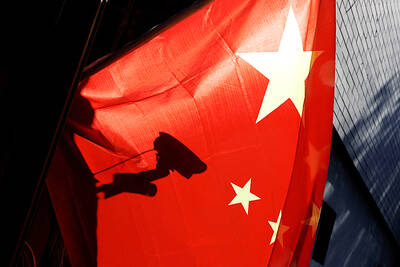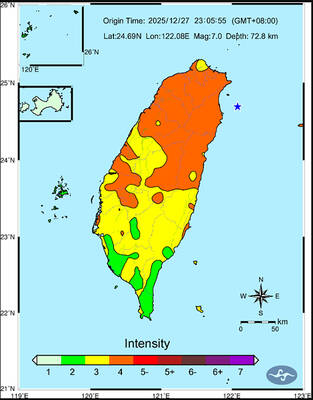After nearly eight hours of discussion, a panel reviewing a petrochemical industrial park project proposed by Kuokuang Petrochemical Technology Co (國光石化) yesterday ruled that the company would have to provide additional information to be resubmitted for further review.
The panel, made up of members of the environmental impact assessment (EIA) committee at the Environmental Protection Administration (EPA), university professors and government representatives, was holding its fourth review.
Prior to the meeting, media reports were speculating that the panel was likely to give the case a conditional approval and allow it to be reviewed by the EIA Committee, which has the final say on whether the proposal should be approved or rejected. Some reports said the chances of such a conclusion being reached were high, because the EPA was seeking to settle the controversial project before the Lunar New Year holiday next week.
While the panel did not approve the plan, its ruling still fell short of the expectations of the project’s opponents, who asked that Kuokuang drop it altogether.
Although Kuokuang has proposed reducing the scale of the planned petrochemical complex, critics said the watered-down project still poses a threat to the environment.
Liu Chung-ming (柳中明), a professor at National Taiwan University (NTU), said that while extreme weather was causing disasters worldwide, the Kuokuang proposal did not assess the impact of such weather occurrences on its operations.
Allen Chen (陳昭倫), an associate research fellow at the Biodiversity Research Center at Academia Sinica, said Kuokuang must carefully assess the project’s impact on the natural habitat of the Indo-Pacific humpback dolphin.
“The [humpback dolphin] issue needs to be handled as a global matter,” Chen said. “However, looking at the reports submitted by the developer, we find [that Kuokuang] has left many questions unanswered.”
Although she was not present at the meeting, Yunlin County Commissioner Su Chih-feng (蘇治芬) said in a statement that she opposed the project, adding that air pollution from the proposed petrochemical plant could cause an estimated NT$10 billion (US$344 million) in damage annually.
Furthermore, the average life expectancy of residents could be reduced by 61 days, she said.
Panelists did not start reviewing the case until late in the afternoon, as the panel had allocated about five hours for supporters as well as opponents of the project to voice their opinions.
Kuokuang chairman Chen Bao-lang (陳寶郎) said the company believed it was heading in the right direction by scaling down the project.
“It will reduce pollution and decrease water usage,” Chen said. “Still, [the panelists] wanted us to provide specific details as to how reducing the size of the project will do less harm to the environment.”
On the ruling, Chen said differences of opinion were expected.
“People will always have opinions no matter how prepared you are,” he said.
Chiang Pen-chi (蔣本基), a professor at National Taiwan University who presided over the meeting, said the panel would hold a fifth meeting to review the matter, though a date had yet to be determined.
Meanwhile, after demonstrating outside the EPA building for about 24 hours, students, environmentalists and Changhua County residents opposed to the industrial park rejoiced when they heard the results of the meeting.
“This is not the most satisfactory outcome, but this is at least an acceptable one and we welcome it,” Yao Liang-yi (姚量議), one of the organizers of the overnight rally, said through a loudspeaker. “The meeting reached this conclusion because of you [the demonstrators], because of your pressure.”
Hundreds of mainly students representing universities across the country launched the overnight rally against the project at about 7pm on Wednesday. The students were then joined by Changhua County residents who arrived in buses at about 9am — half an hour before the evaluation meeting was to begin.
Opposition to the project stems from the plan to build the plant on an manmade island not far off the coast of Dacheng Township (大城), Changhua County, which is considered ecologically sensitive wetland.
In addition to the rich ecosystem, the area also has a very active marine farming industry that produces more than one-third of the nation’s oysters.
“Decades ago, when the Formosa Plastics Group [台塑集團] announced it would build a petrochemical industrial park in Mailiao Township [麥寮], Yunlin County, people welcomed it, but now they regret it,” said Lin Ching-tuo (林清拖), an elderly farmer from Wanggong Township (王功), Changhua County, which is close to Mailiao and Dacheng.
“The large quantities of smoke produced by oil refineries in Mailiao not only pollute the air, but also damage the health and the quality of life of people in neighboring areas,” Lin said. “Consequently, we should stop the project before it becomes a reality.”
Activist Yang Ru-men (楊儒門), who also runs an organic farm and a farmers’ market, told the crowd that although residents could receive cash compensation for the project, “however much cash you receive, it cannot make up for the loss of your health.”
“Of course economic development could help us live longer, but what good does it do if it means just staying in a hospital bed longer?” he said.

A magnitude 7.0 earthquake struck off Yilan at 11:05pm yesterday, the Central Weather Administration (CWA) said. The epicenter was located at sea, about 32.3km east of Yilan County Hall, at a depth of 72.8km, CWA data showed There were no immediate reports of damage. The intensity of the quake, which gauges the actual effect of a seismic event, measured 4 in Yilan County area on Taiwan’s seven-tier intensity scale, the data showed. It measured 4 in other parts of eastern, northern and central Taiwan as well as Tainan, and 3 in Kaohsiung and Pingtung County, and 2 in Lienchiang and Penghu counties and 1

FOREIGN INTERFERENCE: Beijing would likely intensify public opinion warfare in next year’s local elections to prevent Lai from getting re-elected, the ‘Yomiuri Shimbun’ said Internal documents from a Chinese artificial intelligence (AI) company indicated that China has been using the technology to intervene in foreign elections, including propaganda targeting Taiwan’s local elections next year and presidential elections in 2028, a Japanese newspaper reported yesterday. The Institute of National Security of Vanderbilt University obtained nearly 400 pages of documents from GoLaxy, a company with ties to the Chinese government, and found evidence that it had apparently deployed sophisticated, AI-driven propaganda campaigns in Hong Kong and Taiwan to shape public opinion, the Yomiuri Shimbun reported. GoLaxy provides insights, situation analysis and public opinion-shaping technology by conducting network surveillance

Taiwan is gearing up to celebrate the New Year at events across the country, headlined by the annual countdown and Taipei 101 fireworks display at midnight. Many of the events are to be livesteamed online. See below for lineups and links: Taipei Taipei’s New Year’s Party 2026 is to begin at 7pm and run until 1am, with the theme “Sailing to the Future.” South Korean girl group KARA is headlining the concert at Taipei City Hall Plaza, with additional performances by Amber An (安心亞), Nick Chou (周湯豪), hip-hop trio Nine One One (玖壹壹), Bii (畢書盡), girl group Genblue (幻藍小熊) and more. The festivities are to

AFTERMATH: The Taipei City Government said it received 39 minor incident reports including gas leaks, water leaks and outages, and a damaged traffic signal A magnitude 7.0 earthquake struck off Taiwan’s northeastern coast late on Saturday, producing only two major aftershocks as of yesterday noon, the Central Weather Administration (CWA) said. The limited aftershocks contrast with last year’s major earthquake in Hualien County, as Saturday’s earthquake occurred at a greater depth in a subduction zone. Saturday’s earthquake struck at 11:05pm, with its hypocenter about 32.3km east of Yilan County Hall, at a depth of 72.8km. Shaking was felt in 17 administrative regions north of Tainan and in eastern Taiwan, reaching intensity level 4 on Taiwan’s seven-tier seismic scale, the CWA said. In Hualien, the